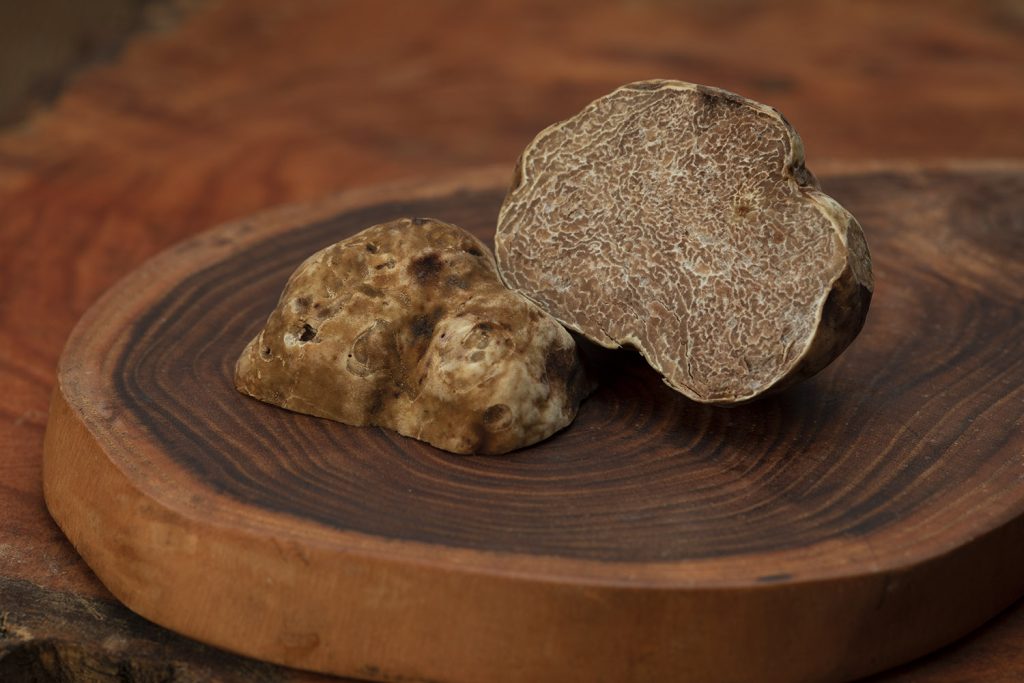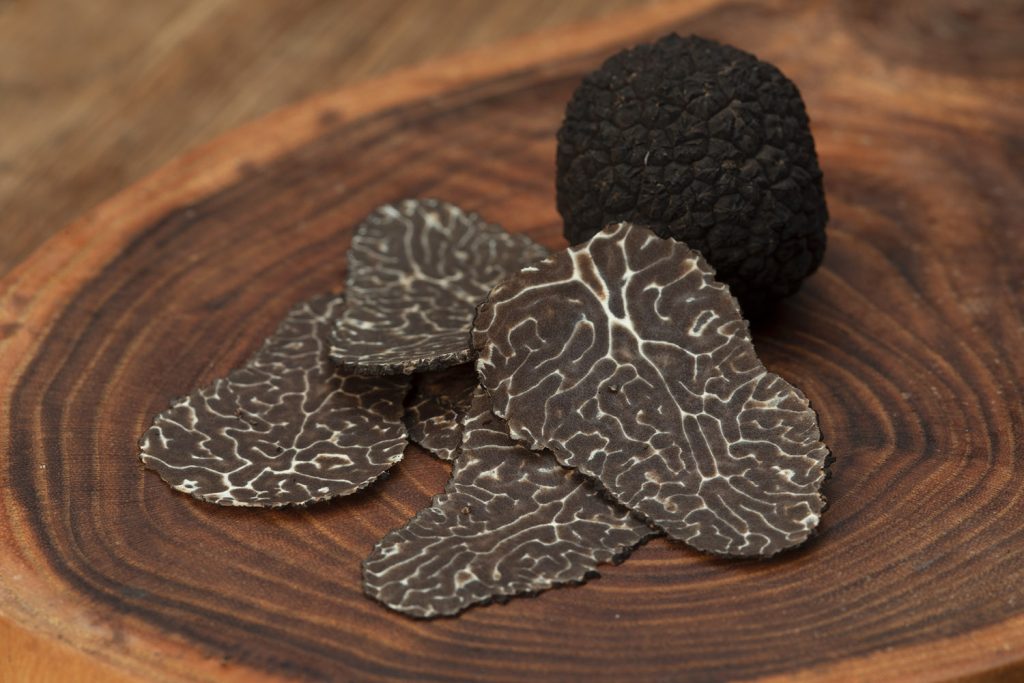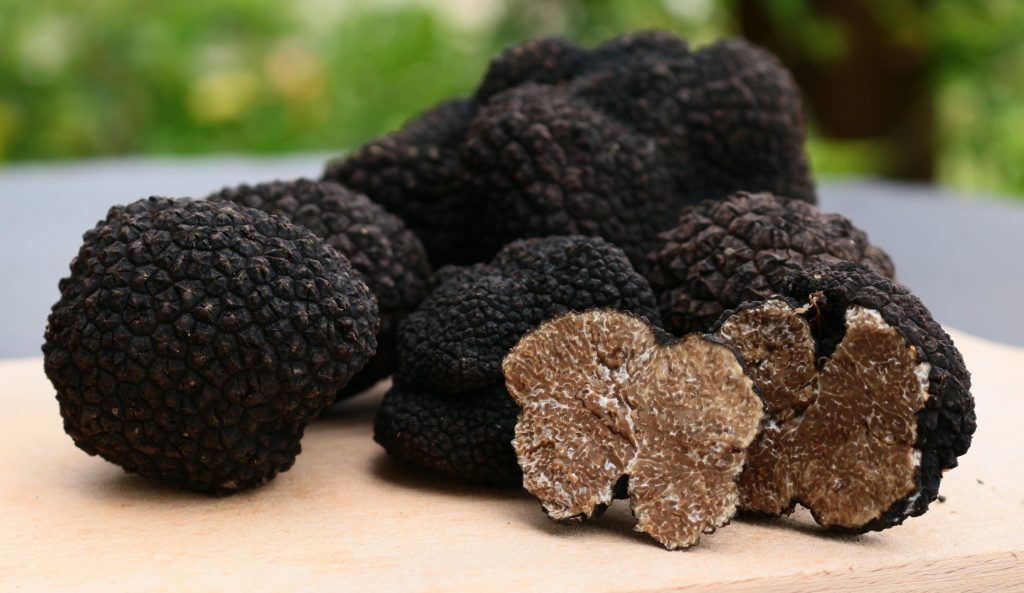Truffle farming
About truffles
Truffles are fungi that grow 5 – 20 cm under the soil surface on the roots of specific host trees. Truffle and their host trees have special symbiotic relationship (ectomycorrhizal symbiosis): the fungi process nutrients for trees in exchange for sugars absorb from the roots.
In terms of culinary, the following species are the most popular:
White truffle (Tuber magnatum): they grow wild in the forests of the Mediterranean region of Europe (from Italy to Greece). The harvesting season starts in autumn. Their flesh is pale cream, brown with white marbling.


Summer truffle (Tuber aestivum): also called ‘Black summer truffle’. Harvesting time is in summer (from June to September). They have the widest distribution than any other truffle species. Summer truffles are found across Europe, from Spain to eastern Europe, and from Sweden to North Africa. Their bodies are 2 – 10 cm, and their brown/black outer skin forms pyramidal scales.
The flavor, size and color of Summer truffles is similar to Burgundy truffle (Tuber uncinatum) that has a harvesting time from September to December, but their aroma is less intense and the flesh is a paler hazel color.

Truffle farming
Summer truffle and Black truffle have two different cultivation technologies, as they need different climate and soil conditions. Therefore, they not only have different harvesting seasons, but they have significant price differences on the market.
Climate and soil
Climate, soil, and locations are important factors for truffle farming. If you are not sure about the characteristics of your field, a basic soil analysis is required.
Black truffle: likes south-southwest orientation; hot, sunny summer and mild, not too cold winter. It requires alkaline soil pH 7,5 – 8,5 with warm, well-drained, rocky and sandy structure, not too much clay fracture.
Summer truffle: likes east-north orientation; mild, shady, not too hot summer and cold winter. It requires alkaline soil pH 7 – 8 with cool and clammy characteristic, a bit more clay fracture than Black truffle.
(Tip: at both soil type you can add grounded limestone to the soil to raise pH, if required)
Important to know what was previously cultivated on the field. Remaining roots on the field may contain ectomycorrhizal fungi, hence they may contamine the truffle seedlings’ roots with foreign fungi. If there was a forest on the field, you need to wait 5 – 6 years after cleaning to make the native ectomycorrhizal fungi disappear.
These plants do not build ectomycorrhizal symbiosis, so they are good pre-crop for truffle planting:
– all herbaceous plant (annuals, biennials, perennials, monocots and dicots)
– vine, small shrubs (rosemary, lavender, etc.)
These plants build ectomycorrhizal symbiosis, so they are not good pre-crop for truffle planting:
– oak (Quercus sp.), pine (Pinus sp.) cedar (Cedrus sp.), beech (Fagus sp.), linden (Tilia sp.), poplar (Populus sp.), hazel (Corylus sp.), hornbeam (Carpinus sp.),
(Tip: look around which trees grow naturally in your area, then choose similar species for your hosts of truffle trees)
Field preparation
There are different ways to prepare the field before planting the truffle trees.
– Plow the soil 25 – 30 cm deep, then smoothly harrow, so a suitable bed can be created before planting. Either the whole field, or just a few rows with a 2 – 3 m width can be equally prepared.
– If the soil is loose enough, plowing can be skipped. In this case, only rotary harrow is enough to prepare the field accurately.
– If the the field was well-cultivated the previous year, neither plowing nor harrowing is necessary. Using only a flail mower to clean the area will work perfectly.
Plant the truffle trees the same way as other trees or shrubs:
1. dig a hole with at least triple the size of the pot
2. put the tree in the hole a few cm deeper than the plant in the pot
3. fill the hole with fine soil, forming a basin around the tree
4. water the plant with at least a bucket of water.
Mulching
The mulching is very important to keep the soil moist around the plant, and to protect the base against weeds. For the base, both square (50 x 50 cm) or round (50 cm diameter) shapes are suitable..
There are various types of mulching: using plastic, biodegradable materials, or paper.
You can mulch with crushed limestone, which has similar benefits to the other methods, but in addition the limestone that is washed in by rainfall ensures a high soil pH in the root zone.
(Tip: the cheapest end easiest way is to use cardboard)
Tree protection
To protect the freshly planted trees against hares and deers is also very important. If there is no fence around the field, using plant protection sleeves is required. These guards can be made of plastic or metal wire with a diameter 20 – 25 cm and 70 – 100 cm height.
Plant density
To measure the density of a plantation depends on the truffle type:
Black truffle: rows with at least 4 x 4 m, 5 x 5 m, or 4 x 6 m distance (400 – 500 plant per hectare). They like an airy, sunny, and warm soil surface, the recommended row direction is North-South.
Summer truffle: rows with 3 x 3 m, 4 x 3 m, or 4 x 2,5 m distance (800 – 1100 plant per hectare). As they likes shade and moist soil, the recommended direction of the rows is East-West
Irrigation and maintenance
The watering the trees is vital, especially is in the first two years after planting. Water manually at least 10 liters per plant every week or every other week (depending on weather and soil condition). During extremely hot and dry summer months, more frequent watering is necessary.
(Tip: use mulch to keep the soil moist)
After 5 – 6 years, when truffles start to appear, you can maintain good condition by irrigating the truffles (not the plants). The best way is to set up a micro sprinkler around the trees: water with it every 2nd or 3rd week, adapted to the actual soil and climate condition.
If using mulch, keep it around the trees and mow the grass in the firs 3 years.
After 3 years, the plants are strong enough to remove the mulch and start a proper tillage.
The soil work has to be performed around March every year, either with a hoe around the plants, or with a cultivator / harrow with a 15 – 20 cm depth. The soil work has great benefits, such as aeration of the soil, root pruning, stimulating the growth of juvenile roots, and controlling the weeds.
